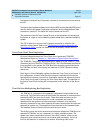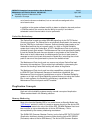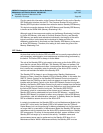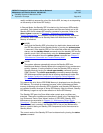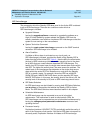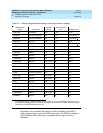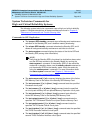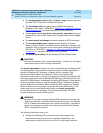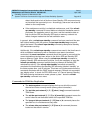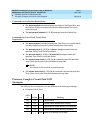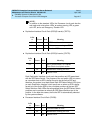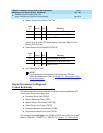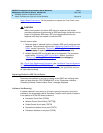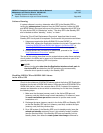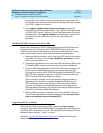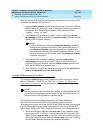
DEFINITY Enterprise Communications Server Release 5
Maintenance and Test for R5vs/si
555-230-123
Issue 1
April 1997
Reliability Systems: A Maintenance Aid
Page 6-15System Technician Commands for High and Critical Reliability Systems
6
detect faults and/or lack of faults on those Standby SPE components may
not have had the opportunity to run. Accordingly, alarms are not raised or
retired on the components.
■ If the maintenance activity is scheduled maintenance, and if the refresh
spe-standby command is issued before a scheduled translation save is
performed, the translation save is not done, and the translation data on
both the Active SPE and Standby SPE tapes or memory cards do not
reflect changes made since the last translation save.
In general, after a refresh spe-standby command has been used and the user
has finished working with the system, the test spe-standby long command
should be issued if the refresh spe-standby command preempted a Standby
SPE maintenance activity.
Additionally, if the refresh spe-standby command was used in the time frame in
which scheduled maintenance with a translation save was to have been
conducted, the save translation command should be issued to ensure that the
current translation data has been written to the Active SPE and Standby SPE
tapes or Memory Cards. When using the refresh spe-standby command to
preempt Standby SPE maintenance activities, it may be necessary to issue the
refresh spe-standby command multiple times to preempt all Standby SPE
maintenance activity. If the refresh spe-standby command successfully
completes five times without the Standby SPE becoming labeled “standby” on
the status system form, wait 20 minutes. This does not include cases where the
command completes with the G3MT terminal message “Refresh not successful;
use ‘display errors’ to check for STBY-SPE errors” or “Cannot interrupt Standby
SPE while entering maintenance mode; please try later.” Issue the refresh
spe-standby command once more.
Commands for TDM Bus Duplication
■ The status system command displays the bus on which the control
channel and tones currently reside (among other information).
■ The test tdm port-network [1 | 2 | 3] [short | long] command tests both
TDM Buses.
■ The set tdm port-network [1 | 2 | 3] a | b [override] command moves the
control channel and dedicated tones to the specified TDM Bus.
■ The busyout tdm port-network [1 | 2 3] bus a | b command places the
specified bus in a maintenance busy state.
■ The release tdm port-network [1 | 2 3] bus a | b command places a
busied-out bus back in service.



